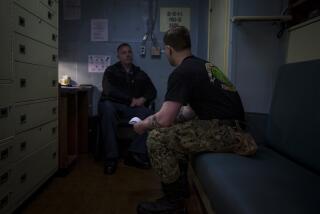Going Batty : Chapel Prays Belfry Will Divert Creatures
- Share via
POINT MUGU — Holy guano! Bats in the chapel!
All of God’s creatures are welcome in the Chapel of Faith, the nondenominational house of worship on the Point Mugu Navy base.
Yet the bunch of Mexican free-tailed bats that hang from the rafters are testing the patience of those sworn to be the most understanding in the Kingdom of God.
With the flip of a light switch, they fly helter-skelter around the A-framed building. They bring shrieks from the choir, as the most squeamish fear that an erratic flight pattern is really a dive-bomb run.
And they heap extra chores on those who otherwise love doing the Lord’s work.
The first daily task is to wipe the droppings off the pews. And then sweep the piles from rows. The aisles. The lobby. And, as if nothing is sacred, even clean the sanctuary of the tiny black pellets that have rained from above for the past five years.
“They poop all over everything,” said Navy Chaplain Don Moss. “All of our altar clothes have to be put away between services. If we leave them out, they will be covered with guano.”
The Point Mugu Naval Air Warfare Center certainly has the firepower to eliminate the little winged intruders. After all, its basic mission is to test-fire missiles and other powerful weaponry.
But the Navy wants to keep bats on the base it built on boggy marshland that provides a fertile breeding ground for mosquitoes and other insects.
Bats are nature’s bug-zappers, Navy environmentalists point out. A typical small brown bat eats 600 mosquitoes an hour as it darts about.
So instead of flushing the flying mammals from the building, the Navy has fashioned some alternative housing.
“So you are building a belfry for my bats,” Chaplain Jim Pope said, clasping his hands together as he watched public works crews mount an 850-pound shelter onto the chapel’s steep roof. “It looks like it ought to work. It’s a nice bat motel.”
The A-framed structure took weeks to design and assemble by the base’s engineers and its carpentry, sheet metal and welding shops. Now that the bat house sits atop the chapel, like a rudder on the ship of Christ, Navy officials are waiting for the bats to make their move.
Just what does it take to coax a bat into a government-issue bat condo?
One technique used by Navy workers was to mix a slurry of guano and water and smear it inside the new abode. The idea was to give it a homey, familiar smell.
Another was to install narrow slats inside the house. Bats like to wedge their tiny bodies into tight places.
A third was to position the bat house so it catches the same warming rays of sunlight as the chapel. Scientists hope the climate will mimic that of the rafters--an important criterion for temperature-fussy bats.
But even with those accommodations, some bats hang out, well, wherever they want to.
“They have wonderful quarters now, I don’t know why they would want to move,” said Patricia Brown, a bat expert and research associate at UCLA who was brought in as a consultant. “People shouldn’t take it as a personal affront if they don’t move into the bat house.”
Still, the effort is, as Brown said, “good bat PR.”
She likens it to people who install birdhouses in their backyard, even though only a small fraction of them are ever used as a nest. “It makes people feel good that they are doing something for them.”
Unlike years past, the Navy now works hard at being a good environmental steward of its land.
Point Mugu has a sizable shop of biologists, engineers and environmentalists who try to protect the base’s endangered species and other critters that feed or nest in Mugu Lagoon and the surrounding wetlands.
Navy officials spray malathion near the base housing to keep down mosquitoes. They apply another natural bug-controlling agent in the wetlands.
“The bats are really helpful in controlling mosquitoes,” said Steve Schwartz, one of the base’s top environmental managers. “We want to keep the bats here, but alleviate everyone’s fear of a health hazard.”
Bats get a bum rap, the experts say.
The indigenous species of bats feast on bugs, not blood. They don’t dive-bomb people. They don’t get caught in human hair. Their droppings do not carry disease.
“It’s more of an aesthetic thing than a health concern,” Brown said.
Like other mammals, bats can contract rabies, but it is rare, Brown said. “That’s not a problem unless you find a grounded bat and you try to handle it. No one should go around picking up sick, grounded bats.”
Bats roost in a number of buildings on base, but the chapel got the most attention because of its high visibility. And so it has become the site for Point Mugu’s first experimental bat house. Navy workers may later use wire mesh to cover vents and other small openings in the chapel to prevent the bats from returning inside.
“We hope to have a full-scale relocation program,” Schwartz said, “if we can just get a little cooperation.”
More to Read
Sign up for Essential California
The most important California stories and recommendations in your inbox every morning.
You may occasionally receive promotional content from the Los Angeles Times.










